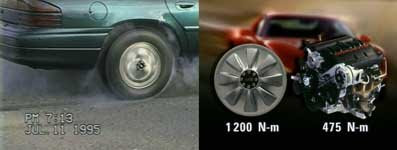liveforphysics
100 TW
moderator edit: this thread was split-off from an evolving discussion in the Emrax motor thread, found here:
https://endless-sphere.com/forums/viewtopic.php?f=30&t=88884
xxxxxxxxxxxxxxxxxxxxxxxxxxxxxxxxxx
I didn't realize I had a spokesman who preaches confusion in my name for me.
If you want to have say 100kW, and you have say 100 cells to make the math easy, if you put all 100 cells in parallel, and you draw 100kW, you are loading each cell at 1kW, it has the voltage sag of a 1kW load and it makes the heat of being loaded at 1kW per cell. If you arrange the same 100cells into a series string and draw the same 100kW from it, each cell is loaded at the same 1kW per cell, each cell has the same voltage sag, each cell makes the heating of 1kW discharge per cell etc.
What changes is the cross section needed in the power busing. If you are able to locate your battery at your inverter, and your inverter at your motor, then your bussing mass can approach zero, no matter the cross section required.
Current is not the enemy of EVs, it just requires doing real interconnections correctly. Voltage and its capacitively coupled efields and corrosion potential and corona and dielectric breakdown from humidity and/or UV exposure are in my own limited set of life experiences, much greater issues to overcome than getting high current interconnects right.
That said, I respect your own thoughts on it and you're welcome to believe/preach anything you like.
https://endless-sphere.com/forums/viewtopic.php?f=30&t=88884
xxxxxxxxxxxxxxxxxxxxxxxxxxxxxxxxxx
methods said:You know I love porn Doc... Good job... But the blog was down.
Magnets:. Glue alone is not acceptable to me. It will age and fail... Or quality in Production will create great risk for failure. Good Production pieces can not fail (Mill Spec).
As for the tiring arguments around making power with Volts and not Amps...
Volts
Yes there is the copper weight issues with big current.
Yes there is the I^2*R issue at every connector and bolt
More importantly is wear and tear on Batteries.
When taking Luke advice it is important to know what he is up to. Luke is an extreme guy... He wants extreme things... Like... A 20Ah battery that can discharge at 2000A.
That's cool... Plenty of need for that... But I see a different need in our sector.
Low cost
High cycle count
Light weight
If I can string cells in series and pull 1C off of them instead of 10C with bursting of 30C... This treats the chemistry better and will result in longer life. I would like my cells to cycle thousands of times... And I have never seen cells last that many cycles while discharging at super high rates.
Not here to argue.
Let's just see what the lifecycle ends up being on Luke's 28S packs. They get pushed pretty hard... Upward of thermal limits. My guess is they will show premature wear.
It is nice to be able to charge fast. That is of super high value.
I can say this:. As lithium batteries get used and abused their internal resistance goes up over time. IF you depend on that IR being low then performance will degrade with time... As users bump against thermal limits.
On the other hand... If you make power with voltage and draw only 1C off your cells... The internal resistance can go up and it will have much less effect (exponentially less).
Drag racing and Motorcycles are one slice of a very big pie. They have strict boundaries and clear goals. These limitations and goals do not nessesary align with the limits and goals of other platforms.
Then there is simple scaling.
420V 1000A Tesla
Do you think you will see 105V 4000A Tesla
No
You won't
Ever
Ohm's law.
To break it is to fail to scale.
-methods
I didn't realize I had a spokesman who preaches confusion in my name for me.
If you want to have say 100kW, and you have say 100 cells to make the math easy, if you put all 100 cells in parallel, and you draw 100kW, you are loading each cell at 1kW, it has the voltage sag of a 1kW load and it makes the heat of being loaded at 1kW per cell. If you arrange the same 100cells into a series string and draw the same 100kW from it, each cell is loaded at the same 1kW per cell, each cell has the same voltage sag, each cell makes the heating of 1kW discharge per cell etc.
What changes is the cross section needed in the power busing. If you are able to locate your battery at your inverter, and your inverter at your motor, then your bussing mass can approach zero, no matter the cross section required.
Current is not the enemy of EVs, it just requires doing real interconnections correctly. Voltage and its capacitively coupled efields and corrosion potential and corona and dielectric breakdown from humidity and/or UV exposure are in my own limited set of life experiences, much greater issues to overcome than getting high current interconnects right.
That said, I respect your own thoughts on it and you're welcome to believe/preach anything you like.



